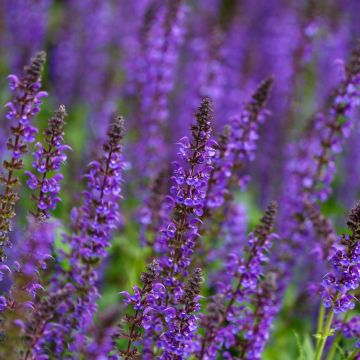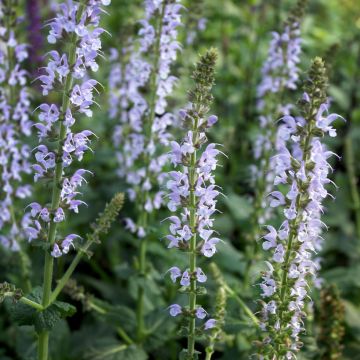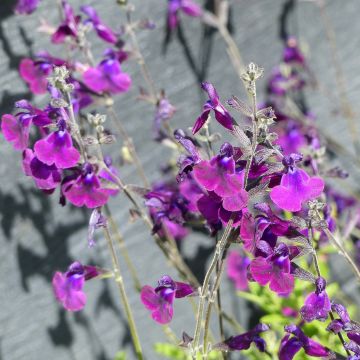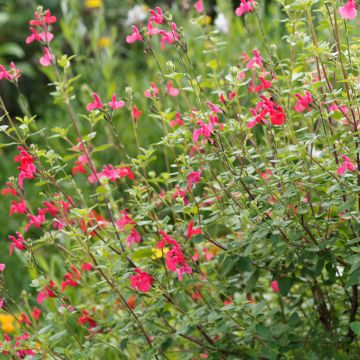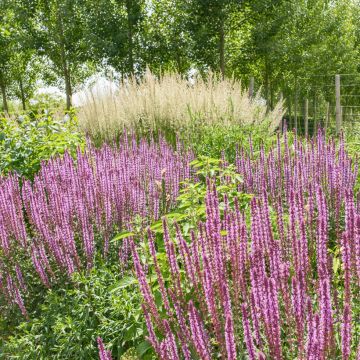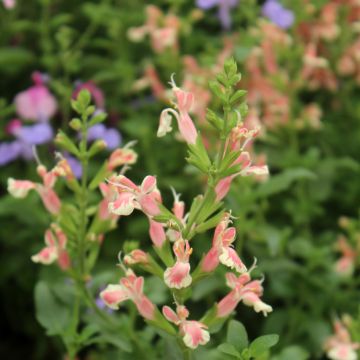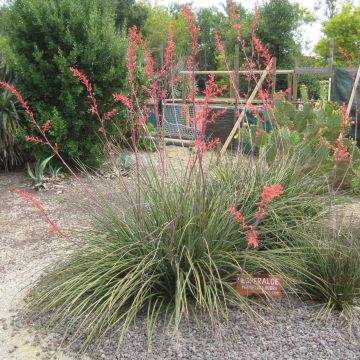

Salvia jamensis Pluenn


Salvia jamensis Pluenn


Salvia jamensis Pluenn
Salvia jamensis Pluenn
Salvia x jamensis Pluenn®
Sage
The sage ordered along with several other plants was packed head to toe with other plants, apparently squeezed into the same box. The box was intact but inside, several branches of the sage, among others, were broken.
Joële, 16/10/2024
Special offer!
Receive a €20 voucher for any order over €90 (excluding delivery costs, credit notes, and plastic-free options)!
1- Add your favorite plants to your cart.
2- Once you have reached €90, confirm your order (you can even choose the delivery date!).
3- As soon as your order is shipped, you will receive an email containing your voucher code, valid for 3 months (90 days).
Your voucher is unique and can only be used once, for any order with a minimum value of €20, excluding delivery costs.
Can be combined with other current offers, non-divisible and non-refundable.
Why not try an alternative variety in stock?
View all →This plant carries a 12 months recovery warranty
More information
We guarantee the quality of our plants for a full growing cycle, and will replace at our expense any plant that fails to recover under normal climatic and planting conditions.
Would this plant suit my garden?
Set up your Plantfit profile →
Description
Salvia x jamensis Pluenn is a delightful variety of shrubby sage selected for its regular, compact, and well-branched habit that highlights an abundant flowering of a very bright salmon pink. From summer until the first frost its flowers gather in dense clusters on dark stems, with small evergreen leaves, dark green and highly aromatic. This excellent hybrid only requires very well-drained even mediocre limestone soil, in sunny or partially shady exposure to thrive. This variety adapts wonderfully to container gardening.
Salvia x jamensis is a natural hybrid of Salvia greggii and Salvia microphylla, frequently found in the mountains of Mexico. 'Pluenn' is a recent cultivar obtained in France by Cathy Pluenn. Like all salvias, it belongs to the large family of lamiaceae or labiates. This shrubby perennial has a very bushy, well-branched, rounded habit, almost as wide as it is tall. It will reach 60 cm (24in) in all directions, or even more in fertile soil. The nectar-rich flowering is particularly generous, starting in early summer, slowing down if July is dry, and then lasting until November if cold does not put an end to it. The elongated flowers emerge from the foliage, clustered in spikes on dark purple-brown stems. They measure no more than 2-3 cm (1in) in length and are adorned with a vivid salmon-pink hue, enhanced by small brown bracts at the base. They barely last a day, covering the ground with their petals in the evening, but will already be replaced the next morning. The foliage is often evergreen and composed of small ovate, dark green, thick, and aromatic leaves, slightly sticky, releasing a strongly acidic-scented essential oil with heat. They measure from 1 to 2 cm (1in) in length. This variety is hardy down to -10°C (14°F) in well-drained soil.
The lower autumn light enhances the flowering of shrubby salvias, which capture the light through their petals like tiny stained glass windows. These plants are part of those that have contributed to the notoriety of the Salvia genus: minimal maintenance, but almost uninterrupted flowering from spring until the first frost. They are found in English cottage gardens and Mediterranean gardens. This 'Pluenn' sage pairs well with blue or white-flowered varieties. But its association with tall grasses or autumn asters is fabulous: choose those that are easy to grow, such as Aster laevis, Aster turbinellus, or Aster amellus for example. gauras, tall sedums (Sedum 'Matrona'), shrub potentillas, and the silver foliage of artemisias or silver ragworts will compose a charming tableau with it. On the terrace, place it in a large pot, covering its base with bright blue lobelia, right next to a Salvia leucantha ; the colour combination in October is fantastic!
In Mexico, a delicious tea is made with the leaves of this sage, which is called 'mountain myrtle' there.
Salvia jamensis Pluenn in pictures




Flowering
Foliage
Plant habit
Botanical data
Salvia
x jamensis
Pluenn®
Lamiaceae
Sage
Cultivar or hybrid
Other Salvia - Sage
View all →Planting and care
Easy to grow, the Pluenn shrubby Sage can be planted all year round, except during freezing periods. It can withstand temperatures as low as -10°C (14°F) in well-drained soil, enriched with gravel or coarse sand, in sunny and wind-sheltered areas. It can be planted in a sunny or partially shaded position. It is a plant that thrives in light, moist but well-drained soil. It is also suitable for dry soil, which is why it is better to forget to water it rather than to overwater it. At planting, you can provide it with a base fertilizer. Apply a mulch as the cold weather approaches, or cover the plant with fleece. Watering is beneficial in summer, during prolonged droughts. As for pruning, lightly trim the stems that compromise the symmetry and cut back to 20 cm (8in) from the ground, after the last strong spring frosts (in March-April depending on the region). Remove faded flowers when possible.
Planting period
Intended location
Care
Planting & care advice
-
, onOrder confirmed
Reply from on Promesse de fleurs
Similar products
Haven't found what you were looking for?
Hardiness is the lowest winter temperature a plant can endure without suffering serious damage or even dying. However, hardiness is affected by location (a sheltered area, such as a patio), protection (winter cover) and soil type (hardiness is improved by well-drained soil).

Photo Sharing Terms & Conditions
In order to encourage gardeners to interact and share their experiences, Promesse de fleurs offers various media enabling content to be uploaded onto its Site - in particular via the ‘Photo sharing’ module.
The User agrees to refrain from:
- Posting any content that is illegal, prejudicial, insulting, racist, inciteful to hatred, revisionist, contrary to public decency, that infringes on privacy or on the privacy rights of third parties, in particular the publicity rights of persons and goods, intellectual property rights, or the right to privacy.
- Submitting content on behalf of a third party;
- Impersonate the identity of a third party and/or publish any personal information about a third party;
In general, the User undertakes to refrain from any unethical behaviour.
All Content (in particular text, comments, files, images, photos, videos, creative works, etc.), which may be subject to property or intellectual property rights, image or other private rights, shall remain the property of the User, subject to the limited rights granted by the terms of the licence granted by Promesse de fleurs as stated below. Users are at liberty to publish or not to publish such Content on the Site, notably via the ‘Photo Sharing’ facility, and accept that this Content shall be made public and freely accessible, notably on the Internet.
Users further acknowledge, undertake to have ,and guarantee that they hold all necessary rights and permissions to publish such material on the Site, in particular with regard to the legislation in force pertaining to any privacy, property, intellectual property, image, or contractual rights, or rights of any other nature. By publishing such Content on the Site, Users acknowledge accepting full liability as publishers of the Content within the meaning of the law, and grant Promesse de fleurs, free of charge, an inclusive, worldwide licence for the said Content for the entire duration of its publication, including all reproduction, representation, up/downloading, displaying, performing, transmission, and storage rights.
Users also grant permission for their name to be linked to the Content and accept that this link may not always be made available.
By engaging in posting material, Users consent to their Content becoming automatically accessible on the Internet, in particular on other sites and/or blogs and/or web pages of the Promesse de fleurs site, including in particular social pages and the Promesse de fleurs catalogue.
Users may secure the removal of entrusted content free of charge by issuing a simple request via our contact form.
The flowering period indicated on our website applies to countries and regions located in USDA zone 8 (France, the United Kingdom, Ireland, the Netherlands, etc.)
It will vary according to where you live:
- In zones 9 to 10 (Italy, Spain, Greece, etc.), flowering will occur about 2 to 4 weeks earlier.
- In zones 6 to 7 (Germany, Poland, Slovenia, and lower mountainous regions), flowering will be delayed by 2 to 3 weeks.
- In zone 5 (Central Europe, Scandinavia), blooming will be delayed by 3 to 5 weeks.
In temperate climates, pruning of spring-flowering shrubs (forsythia, spireas, etc.) should be done just after flowering.
Pruning of summer-flowering shrubs (Indian Lilac, Perovskia, etc.) can be done in winter or spring.
In cold regions as well as with frost-sensitive plants, avoid pruning too early when severe frosts may still occur.
The planting period indicated on our website applies to countries and regions located in USDA zone 8 (France, United Kingdom, Ireland, Netherlands).
It will vary according to where you live:
- In Mediterranean zones (Marseille, Madrid, Milan, etc.), autumn and winter are the best planting periods.
- In continental zones (Strasbourg, Munich, Vienna, etc.), delay planting by 2 to 3 weeks in spring and bring it forward by 2 to 4 weeks in autumn.
- In mountainous regions (the Alps, Pyrenees, Carpathians, etc.), it is best to plant in late spring (May-June) or late summer (August-September).
The harvesting period indicated on our website applies to countries and regions in USDA zone 8 (France, England, Ireland, the Netherlands).
In colder areas (Scandinavia, Poland, Austria...) fruit and vegetable harvests are likely to be delayed by 3-4 weeks.
In warmer areas (Italy, Spain, Greece, etc.), harvesting will probably take place earlier, depending on weather conditions.
The sowing periods indicated on our website apply to countries and regions within USDA Zone 8 (France, UK, Ireland, Netherlands).
In colder areas (Scandinavia, Poland, Austria...), delay any outdoor sowing by 3-4 weeks, or sow under glass.
In warmer climes (Italy, Spain, Greece, etc.), bring outdoor sowing forward by a few weeks.






























